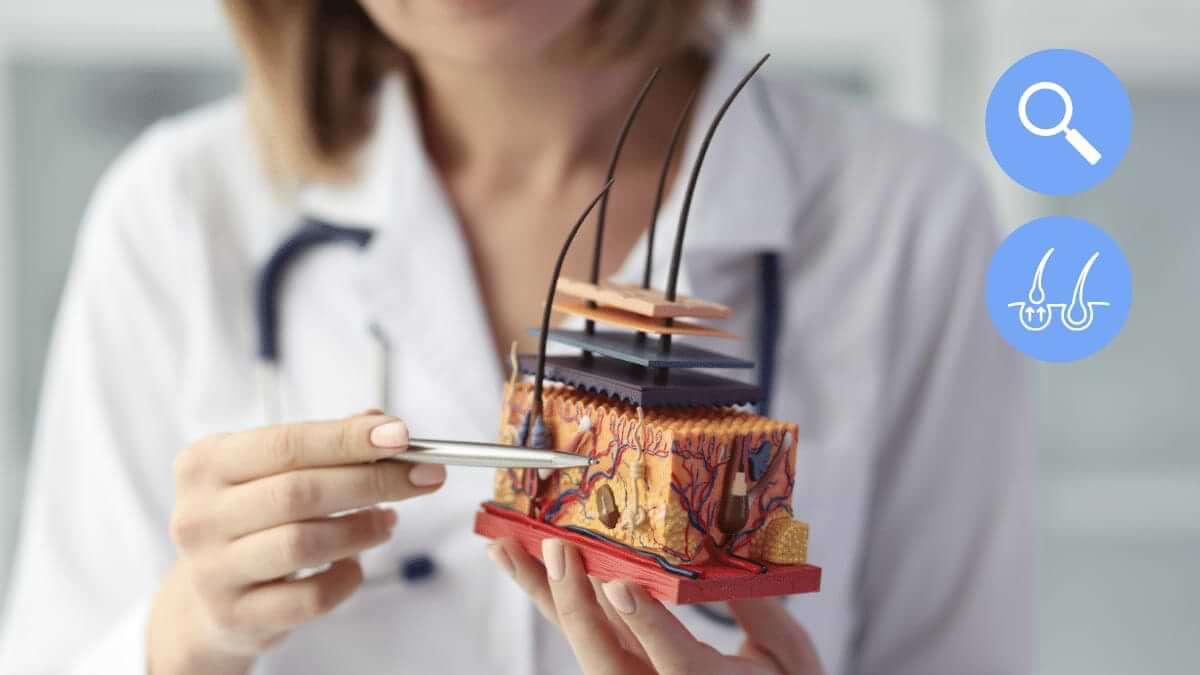For many hair transplant candidates, researching and understanding the process can be difficult.
The surgery process alone is filled with medical terms and topics that may seem like a lot, which is normal.
Among these terms and topics, probably the most common ones you will see are hair grafts and follicles.
That is why in today’s article, I will explain what hair grafts and follicles are, how many hairs they contain, and what makes them important:
Table of Contents
Let’s start by understanding what they are:
What Is a Hair Graft?
Let’s go simple and step-by-step.
In our daily lives, we call the entire covered area of our scalps hair. However, in medical terms, it refers to a singular strand. 🩺
Hair is a keratin protein fiber that grows out of a hair follicle in the skin. A group of 1-4 hairs forms grafts.
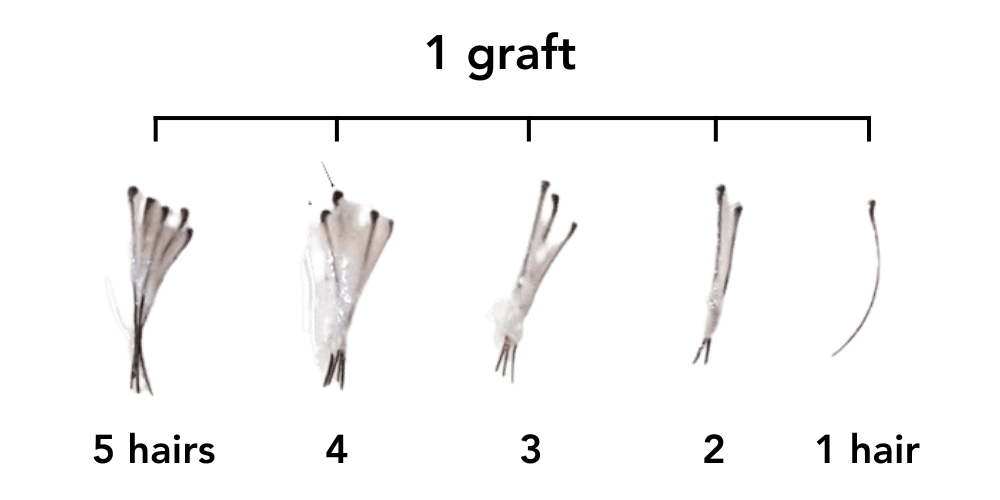
There is no exact number of hairs in a single graft, as the number can change from one to several; however, the worldwide average for a single graft is two hairs.
💡 So, a graft is a follicular unit that is a collection of approximately 1 to 4 hair strands.
Essentially, we use hair grafts to cover the balding areas during hair transplantation surgeries.
But what are hair follicular units and hair follicles?
What Is a Hair Follicular (Unit)?
“The hair follicular unit” is the categorical name we give to each strand of hair; they may be a single hair piece or multiple hairs collected together in a hair graft. Both of them are units.
Follicles, on the other hand, are the medical term for a single hair strand.
👉 In summary, hair grafts are hair follicular units that are made out of single or multiple hair follicles.
Ultimately, what makes hair grafts (and the units within) important is not their definition but their amount and health because those directly affect the success of your hair transplant surgery.
Based on these factors, we determine where to transplant them:
Which Graft Should Be Transplanted in Where?
In a hair transplant, we have different options for suitable donor areas. That is why, for optimal results, we categorize the scalp to find areas that we find to be full of healthy hair grafts.
The scalp is divided into 7 regions. In the 8th region, hair loss is not common.
Some parts of the 7th and 8th regions can be used as donor areas. The safe donor area is located in these two regions.
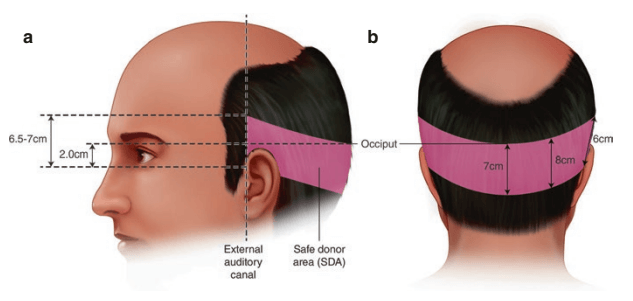
Once we determine the donor areas, we begin the extraction and categorization, which involves three steps:
1️⃣ After the extraction, we start to divide the grafts into groups.
2️⃣ The first and foremost hair group is the single grafts. We implant single grafts to the frontal zone because, before baldness, the frontal zone has mostly single hair grafts.
3️⃣ Then, we divide the rest of the grafts into groups with two hairs or three hairs. And implant each homogenous hair graft in the same zone until we reach the end of the scalp.
However, once we come to implantation, there is another part we must calculate: The amount.
The more hair loss intensity you have in a zone, the more grafts you need.
So, we divide your hair scalp’s hair loss levels up to three levels based on your needs:
*️⃣ MINIMAL means there is much more hair than skin.
*️⃣ MODERATE means skin and hair are balanced.
*️⃣ SEVERE means much more skin than hair or no hair.
You can see sample intensity levels in the images below:
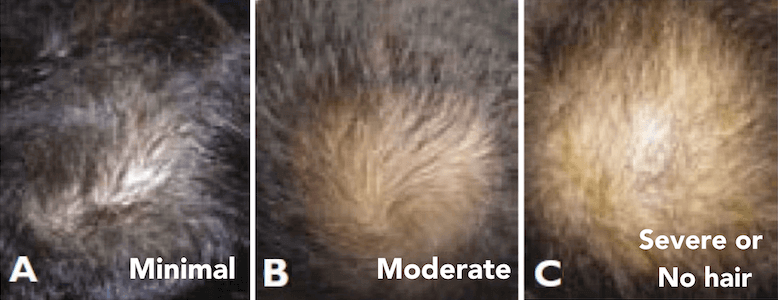
However, remember that regardless of how much your balding areas need, the remaining grafts on your scalp are limited.
The potential number of hair grafts on your scalp can vary a lot depending on your genetics and the quality of your hair. Usually, the numbers are around 6000 to 8000.
And since the remaining numbers are very precious, we have to consider graft depth and density during implantation:
Why Are Graft Depth and Density in a Hair Restoration Surgery Important?
During the transplantation, proper graft depth and density must be measured for precision.
⚠️ In that aspect, the importance lies in the skills and experiences of your chosen doctor, as these sensitive practices can easily turn into failures under inexperienced performers.
Without proper planning, graft depth can create problems in two conditions:
🔷 It can either be too shallow, making the transplant unreliable, or it can be too deep, which completely ignores the spots of the skin where the grafts can be transplanted.
For best practices, my suggestion and choice is the 2 – 3.5mm deep graft depth under the layer.
Similarly, graft density can create problems in two situations:
🔷 It can either be too severe, damaging the skin tissue too harshly, which prevents it from healing itself and killing the grafts, or it can be too sparse, granting undesired results.
For best practices, I prefer and advise the “per-cm2” density, which yields 100 to 110 hair strands out of 45 to 50 grafts.
Ultimately, both graft depth and density require delicate care and attention so that your hair grafts can be safely transplanted:
How Many Hair Grafts Can Be Transplanted?
In a single hair transplant session, between 1000 and 5000 grafts can be transplanted and yield completely different results.
The exact number you need directly depends on how much your baldness has progressed:
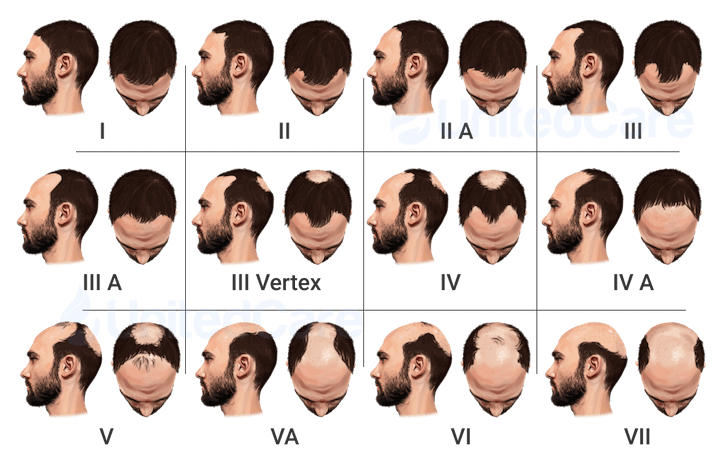
You may need 1000 to 9000 grafts to fully cover your bald or thinning zones.
▶️ If you’ve lost almost all hair in frontal zones, you may need up to 3000 grafts.
▶️ If you have balding only on your crown zones, 1800-2000 grafts are adequate.
If you don’t have any hair on the frontal, crown, and mid-scalp zones, you may need up to 8000-9000 grafts, which can be transplanted in 2 sessions.
However, as the price per graft is more expensive in countries such as the US, UK, and Canada, patients may NOT prefer the maximum possible graft count. Instead, they try to find the balance between cost and coverage.
That is why at UnitedCare, we do NOT charge per graft and try to achieve the best result in line with your wishes.
You don’t have to choose between the two; we provide them both.
Want to learn how many hairs you need to have a full head of hair in 30 seconds?
Do you know how many grafts your scalp needs?
You can find out now:
We aim to maximize the transplant session graft count by observing your safe donor area condition, skin quality, baldness level, and future progression.
To balance safety and success, I personally do NOT recommend getting any more than 5000 grafts in a single session.
⚠️ Otherwise, your hair may fall victim to overharvesting or experience long-term hair transplant failures due to a lack of proper holistic planning and post-surgery care.
That is why you should choose a clinic that knows how to treat your hair grafts delicately:
Treat Your Hair Grafts Right With UnitedCare
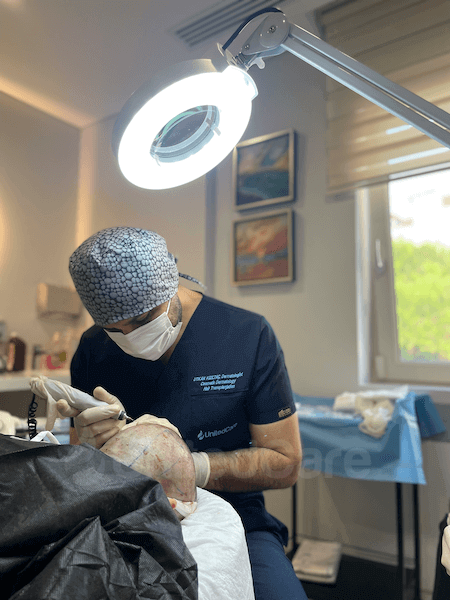
At UnitedCare, we start your harvesting process by separating your grafts based on your hair strand counts to achieve the most natural result. 🍀
🔹 Single hairs are used to draw the frontal hairline.
🔹 Doubles and triples are implanted further back.
💊 Then, we apply liquid storage suitable for ATPv, which combines your hair grafts with bioenhancements to further the transplant’s effectiveness.
Most clinics make graft storage mistakes: They use extracellular storage solutions such as saline or ringer’s lactate and lower the temperature to 4°C, which puts a lot of pressure on live cells and causes loss of hair grafts.
💉 We use intracellular solutions, helping cells stay alive for days outside the body. They increase graft survival rates significantly.
You can find out more about our hair transplant process by applying to our free one-on-one consultation with our expert dermatosurgeons to determine your suitability.
Affordable hair transplant costs, a holistic approach, and experienced dermatologists on-site are here to provide you with the right solution.
Click here to start with a FREE consultation:
Maximize the effectiveness of your transplanted grafts.
Ensure your grafts’ survival with a Dermatosurgeon:
Frequently Asked Questions (FAQs)
How many hairs are in 2000 grafts?
Approximately 4000 hairs are in 2000 grafts. The average number of hairs in a single graft varies from person to person and mainly depends on ethnicity. The number of hairs in a single graft can change between 1 and 5. So, for 2000 grafts, the number of hair strands can change between 2000 and 10000. But roughly, each person is considered to have 2 hairs per graft on average. So, we can say 4000.
What is the total number of hairs contained in 3000 grafts?
Approximately 6000 hair strands are in 3000 grafts.
What is the count of hairs present in 4000 grafts?
The average number is around 8000 hair strands for 4000 grafts.

